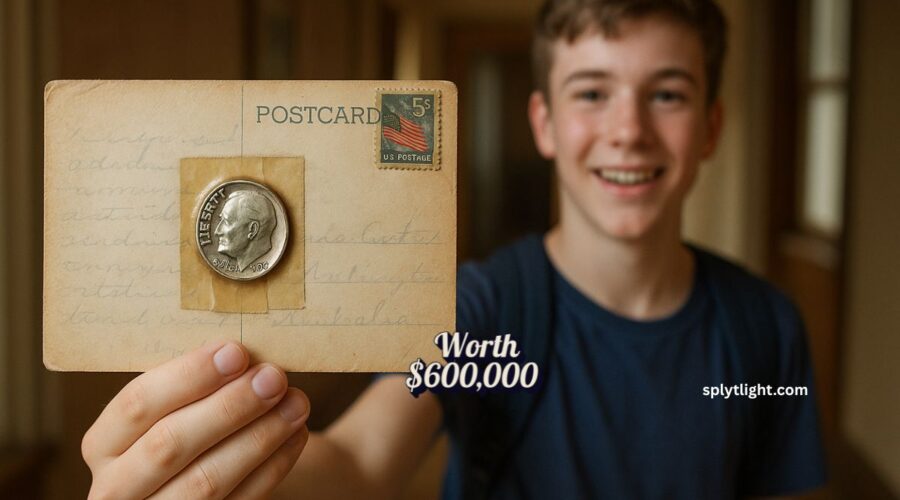Teen Discovers Rare Roosevelt Dime Taped To Postcard — Valued At A Shocking $600,000!
In a story that’s capturing national attention, a 15-year-old teenager recently stumbled upon an astonishing treasure while going through a box of family keepsakes. Hidden behind an old 1960s-era postcard taped inside a photo album was what seemed to be a regular Roosevelt Dime.
However, that dime turned out to be one of the rarest error coins ever found — now estimated to be worth a jaw-dropping $600,000.
What Makes This Dime So Valuable?
At first glance, the coin appeared to be an ordinary 1964 Roosevelt Dime. But after careful inspection by a numismatic expert, it was identified as a transitional error coin. These coins occur when a mint mistakenly uses a planchet (metal blank) from a previous year or material batch.
In this case, the dime was struck on a 90% silver planchet using the clad coinage dies that were supposed to be used for the new copper-nickel composition coins introduced after 1964.
The combination of wrong metal composition, perfect strike, and minimal circulation wear skyrocketed its value.
A Coin Protected by Time and Tape
Despite being taped to the postcard for decades, the coin retained near-mint condition. Experts believe the adhesive may have protected the coin’s surfaces from handling damage, moisture, and oxidation.
Once authenticated and graded, the dime received a high rating, which further boosted its market value. This find proves how important coin preservation can be — even in unusual conditions.
The Historical Context of the Roosevelt Dime
The Roosevelt Dime was first issued in 1946 to honor President Franklin D. Roosevelt, who played a key role in the founding of the March of Dimes campaign to combat polio. While most Roosevelt Dimes have little more than face value, certain years — especially those with errors or transitional characteristics — can be extremely rare.
Breakdown of the Coin’s Characteristics
Here’s a quick summary of the dime’s important attributes:
| Attribute | Details |
|---|---|
| Year | 1964 |
| Type | Roosevelt Dime |
| Error | Transitional Error – struck on silver planchet |
| Composition | 90% Silver |
| Current Value | Estimated at $600,000 |
| Condition | Near Mint |
| Location Found | Taped to a postcard in a photo album |
| Discoverer | 15-year-old teen from Illinois |
Why Transitional Errors Are So Rare
Transitional errors are highly prized in numismatics because they reflect a mistake during a year of major changes in coinage. In 1965, the U.S. Mint switched from silver to copper-nickel clad coins for dimes, quarters, and half dollars. However, a few leftover silver planchets were accidentally used, creating a small number of error coins.
Collectors value such coins because they represent a very limited minting anomaly — sometimes with only a handful known to exist.
Teen’s Family Considers Next Steps
After confirming the coin’s authenticity and getting multiple offers from collectors and dealers, the teen’s family is now weighing their options. They are reportedly considering whether to auction the coin to the highest bidder or hold onto it as a long-term investment.
Regardless of what they choose, this once-forgotten coin has turned into a life-changing asset.
Lessons for Collectors and Families
This discovery reminds us that rare coins can hide in the most unexpected places — from old drawers and attic boxes to vintage letters and scrapbooks. It’s a good idea to check coins for:
- Minting errors
- Incorrect metal composition
- Misplaced or missing mint marks
- Unusual features or anomalies
Everyday change might hold historic or financial value, so coin awareness is essential for anyone interested in collectibles.
The incredible discovery of a $600,000 Roosevelt Dime taped to a decades-old postcard shows how fortune can strike when we least expect it. For coin collectors and enthusiasts, it’s a reminder to keep an eye out — because one rare dime could be the next big find sitting right under your nose.
Whether you’re a seasoned numismatist or just curious about your spare change, this story proves that even the smallest coin can hold the biggest surprises.
FAQs
What is a transitional error in coins?
A transitional error occurs when a coin is struck using a planchet from a previous year or material composition, usually during a transition in minting standards.
How can I tell if I have a rare Roosevelt Dime?
Look for unusual metal composition, missing mint marks, or double dies. Professional grading services can help verify authenticity and value.
Can a coin still be valuable if it has tape or adhesive on it?
Yes, especially if the coin is rare. In some cases, tape has actually helped preserve the coin’s surface, increasing its grade and value.

Leave a Reply Cancel reply